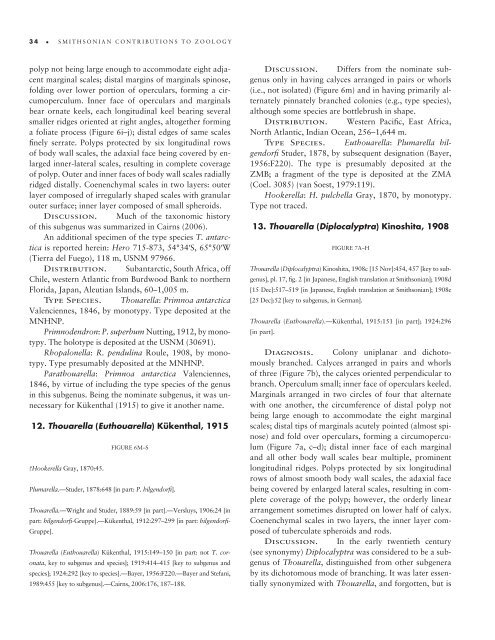A Generic Revision and Phylogenetic Analysis of the Primnoidae
A Generic Revision and Phylogenetic Analysis of the Primnoidae
A Generic Revision and Phylogenetic Analysis of the Primnoidae
Create successful ePaper yourself
Turn your PDF publications into a flip-book with our unique Google optimized e-Paper software.
34 SMITHSONIAN CONTRIBUTIONS TO ZOOLOGY<br />
polyp not being large enough to accommodate eight adjacent<br />
marginal scales; distal margins <strong>of</strong> marginals spinose,<br />
folding over lower portion <strong>of</strong> operculars, forming a circumoperculum.<br />
Inner face <strong>of</strong> operculars <strong>and</strong> marginals<br />
bear ornate keels, each longitudinal keel bearing several<br />
smaller ridges oriented at right angles, altoge<strong>the</strong>r forming<br />
a foliate process (Figure 6i–j); distal edges <strong>of</strong> same scales<br />
fi nely serrate. Polyps protected by six longitudinal rows<br />
<strong>of</strong> body wall scales, <strong>the</strong> adaxial face being covered by enlarged<br />
inner-lateral scales, resulting in complete coverage<br />
<strong>of</strong> polyp. Outer <strong>and</strong> inner faces <strong>of</strong> body wall scales radially<br />
ridged distally. Coenenchymal scales in two layers: outer<br />
layer composed <strong>of</strong> irregularly shaped scales with granular<br />
outer surface; inner layer composed <strong>of</strong> small spheroids.<br />
Discussion. Much <strong>of</strong> <strong>the</strong> taxonomic history<br />
<strong>of</strong> this subgenus was summarized in Cairns (2006).<br />
An additional specimen <strong>of</strong> <strong>the</strong> type species T. antarctica<br />
is reported herein: Hero 715-873, 54°34′S, 65°50′W<br />
(Tierra del Fuego), 118 m, USNM 97966.<br />
Distribution. Subantarctic, South Africa, <strong>of</strong>f<br />
Chile, western Atlantic from Burdwood Bank to nor<strong>the</strong>rn<br />
Florida, Japan, Aleutian Isl<strong>and</strong>s, 60–1,005 m.<br />
Type Species. Thouarella: Primnoa antarctica<br />
Valenciennes, 1846, by monotypy. Type deposited at <strong>the</strong><br />
MNHNP.<br />
Primnodendron: P. superbum Nutting, 1912, by monotypy.<br />
The holotype is deposited at <strong>the</strong> USNM (30691).<br />
Rhopalonella: R. pendulina Roule, 1908, by monotypy.<br />
Type presumably deposited at <strong>the</strong> MNHNP.<br />
Parathouarella: Primnoa antarctica Valenciennes,<br />
1846, by virtue <strong>of</strong> including <strong>the</strong> type species <strong>of</strong> <strong>the</strong> genus<br />
in this subgenus. Being <strong>the</strong> nominate subgenus, it was unnecessary<br />
for Kükenthal (1915) to give it ano<strong>the</strong>r name.<br />
12. Thouarella (Euthouarella) Kükenthal, 1915<br />
?Hookerella Gray, 1870:45.<br />
FIGURE 6M–S<br />
Plumarella.—Studer, 1878:648 [in part: P. hilgendorfi ].<br />
Thouarella.—Wright <strong>and</strong> Studer, 1889:59 [in part].—Versluys, 1906:24 [in<br />
part: hilgendorfi -Gruppe].—Kükenthal, 1912:297–299 [in part: hilgendorfi -<br />
Gruppe].<br />
Thouarella (Euthouarella) Kükenthal, 1915:149–150 [in part: not T. coronata,<br />
key to subgenus <strong>and</strong> species]; 1919:414–415 [key to subgenus <strong>and</strong><br />
species]; 1924:292 [key to species].—Bayer, 1956:F220.—Bayer <strong>and</strong> Stefani,<br />
1989:455 [key to subgenus].—Cairns, 2006:176, 187–188.<br />
Discussion. Differs from <strong>the</strong> nominate subgenus<br />
only in having calyces arranged in pairs or whorls<br />
(i.e., not isolated) (Figure 6m) <strong>and</strong> in having primarily alternately<br />
pinnately branched colonies (e.g., type species),<br />
although some species are bottlebrush in shape.<br />
Distribution. Western Pacifi c, East Africa,<br />
North Atlantic, Indian Ocean, 256–1,644 m.<br />
Type Species. Euthouarella: Plumarella hilgendorfi<br />
Studer, 1878, by subsequent designation (Bayer,<br />
1956:F220). The type is presumably deposited at <strong>the</strong><br />
ZMB; a fragment <strong>of</strong> <strong>the</strong> type is deposited at <strong>the</strong> ZMA<br />
(Coel. 3085) (van Soest, 1979:119).<br />
Hookerella: H. pulchella Gray, 1870, by monotypy.<br />
Type not traced.<br />
13. Thouarella (Diplocalyptra) Kinoshita, 1908<br />
FIGURE 7A–H<br />
Thouarella (Diplocalyptra) Kinoshita, 1908c [15 Nov]:454, 457 [key to subgenus],<br />
pl. 17, fi g. 2 [in Japanese, English translation at Smithsonian]; 1908d<br />
[15 Dec]:517–519 [in Japanese, English translation at Smithsonian]; 1908e<br />
[25 Dec]:52 [key to subgenus, in German].<br />
Thouarella (Euthouarella).—Kükenthal, 1915:151 [in part]; 1924:296<br />
[in part].<br />
Diagnosis. Colony uniplanar <strong>and</strong> dichotomously<br />
branched. Calyces arranged in pairs <strong>and</strong> whorls<br />
<strong>of</strong> three (Figure 7b), <strong>the</strong> calyces oriented perpendicular to<br />
branch. Operculum small; inner face <strong>of</strong> operculars keeled.<br />
Marginals arranged in two circles <strong>of</strong> four that alternate<br />
with one ano<strong>the</strong>r, <strong>the</strong> circumference <strong>of</strong> distal polyp not<br />
being large enough to accommodate <strong>the</strong> eight marginal<br />
scales; distal tips <strong>of</strong> marginals acutely pointed (almost spinose)<br />
<strong>and</strong> fold over operculars, forming a circumoperculum<br />
(Figure 7a, c–d); distal inner face <strong>of</strong> each marginal<br />
<strong>and</strong> all o<strong>the</strong>r body wall scales bear multiple, prominent<br />
longitudinal ridges. Polyps protected by six longitudinal<br />
rows <strong>of</strong> almost smooth body wall scales, <strong>the</strong> adaxial face<br />
being covered by enlarged lateral scales, resulting in complete<br />
coverage <strong>of</strong> <strong>the</strong> polyp; however, <strong>the</strong> orderly linear<br />
arrangement sometimes disrupted on lower half <strong>of</strong> calyx.<br />
Coenenchymal scales in two layers, <strong>the</strong> inner layer composed<br />
<strong>of</strong> tuberculate spheroids <strong>and</strong> rods.<br />
Discussion. In <strong>the</strong> early twentieth century<br />
(see synonymy) Diplocalyptra was considered to be a subgenus<br />
<strong>of</strong> Thouarella, distinguished from o<strong>the</strong>r subgenera<br />
by its dichotomous mode <strong>of</strong> branching. It was later essentially<br />
synonymized with Thouarella, <strong>and</strong> forgotten, but is

















